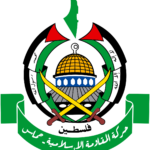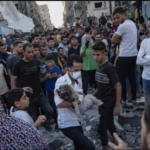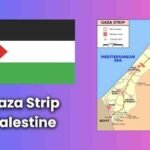Who Are Hamas and Why Do They Hate Israel?: The Israel-Hamas conflict is a long-standing and intricate issue that has witnessed numerous confrontations over the years. In the most recent episode, Hamas, a prominent Palestinian militant Islamist group, launched an attack on Israel, leading to Israel declaring a state of war. This attack involved rocket barrages and border crossings by Palestinian militants, resulting in casualties on both sides. Hamas, a significant political entity in the region, is designated as a terrorist group by multiple nations, including Israel, the United States, the European Union, and the United Kingdom. Formed in the late 1980s, Hamas originated from the Palestinian Muslim Brotherhood and adopted armed resistance as a means to combat Israeli occupation. This blog aims to delve into the history of Hamas and explore why they hold such strong animosity towards Israel.
The Birth of Hamas
Hamas, officially known as the Islamic Resistance Movement, was established in the late 1980s amidst the backdrop of the Israeli-Palestinian conflict. It was a direct outgrowth of the Palestinian Muslim Brotherhood, a religious and political organization that sought to promote Islamic values and governance in Palestinian territories. Hamas’s primary objective was clear from the outset: to resist Israeli occupation and work towards the establishment of an independent Palestinian state.
Armed Resistance Against Israeli Occupation
Hamas chose a path of armed resistance as its primary means of confronting Israeli forces. This decision was partly driven by a belief that peaceful negotiations and diplomacy had failed to secure Palestinian rights and statehood. Additionally, Hamas was critical of the Oslo Peace Accords in the early 1990s, which it saw as compromising Palestinian interests. As a result, the group resorted to tactics such as suicide bombings and attacks against Israeli targets.
Hamas’s Hatred for Israel
To understand why Hamas harbors such intense animosity towards Israel, it’s essential to consider several key factors:
- Historical Context: The Israeli-Palestinian conflict dates back to the mid-20th century when Israel was established, displacing hundreds of thousands of Palestinians. This historical injustice remains a potent source of resentment among Palestinians, and Hamas perceives itself as a defender of Palestinian rights.
- Occupation: Hamas views the Israeli occupation of Palestinian territories, including the West Bank and Gaza Strip, as a major impediment to Palestinian self-determination. The presence of Israeli settlements and military control exacerbates tensions and fuels Hamas’s determination to resist.
- Religious and Nationalist Ideology: Hamas’s ideology combines religious and nationalist elements. They see the struggle against Israel as not only a political fight but also a religious duty. Hamas seeks to establish an Islamic state in Palestinian territories and considers any compromise with Israel as a betrayal of its vision.
- International Backing: Hamas has received support from various regional actors who share their anti-Israel stance. This backing has contributed to the group’s resilience and influence.
Conclusion
Hamas, born out of the Palestinian Muslim Brotherhood, has chosen armed resistance as a response to the Israeli occupation of Palestinian territories. Their strong animosity towards Israel is rooted in historical grievances, ongoing occupation, religious and nationalist ideology, and international support. The Israel-Hamas conflict remains a deeply entrenched issue, and resolving it will require addressing the complex factors that fuel Hamas’s hostility towards Israel.
Here are 50 frequently asked questions (FAQs) along with their answers on the topic of Hamas and its conflict with Israel:
1. What is Hamas?
- Hamas is a Palestinian militant Islamist group.
2. When was Hamas formed?
- Hamas was founded in the late 1980s.
3. What is the full name of Hamas?
- Hamas stands for the “Islamic Resistance Movement.”
4. Where did Hamas originate from?
- Hamas emerged from the Palestinian Muslim Brotherhood.
5. Why did Hamas choose armed resistance?
- Hamas believed that peaceful negotiations and diplomacy had failed to secure Palestinian rights and statehood.
6. What are some tactics used by Hamas against Israel?
- Hamas has used suicide bombings, rocket attacks, and border incursions.
7. Why is Hamas designated as a terrorist group by several nations?
- Hamas is designated as a terrorist group due to its use of violence and attacks against civilians.
8. What is the Oslo Peace Accords, and why did Hamas oppose them?
- The Oslo Peace Accords were a series of agreements aimed at resolving the Israeli-Palestinian conflict. Hamas opposed them, viewing them as compromising Palestinian interests.
9. What is Hamas’s primary objective?
- Hamas’s primary objective is to resist Israeli occupation and work towards the establishment of an independent Palestinian state.
10. Does Hamas have political and military wings? – Yes, Hamas has both political and military wings.
11. What territories do Hamas and Israel dispute? – Hamas and Israel dispute territories, including the Gaza Strip and the West Bank.
12. What is the historical context of the Israel-Hamas conflict? – The conflict dates back to the mid-20th century when Israel was established, displacing many Palestinians.
13. How does the historical injustice fuel Hamas’s hostility towards Israel? – Hamas views itself as a defender of Palestinian rights and seeks to rectify the historical injustice.
14. What role does the Israeli occupation play in the conflict? – The Israeli occupation of Palestinian territories, including the West Bank and Gaza Strip, is a major source of tension.
15. What are Israeli settlements, and why are they contentious? – Israeli settlements are communities built by Israelis in the occupied territories, which Palestinians view as illegal and an obstacle to peace.
16. Does Hamas have any international backing? – Yes, Hamas has received support from various regional actors who share their anti-Israel stance.
17. What is Hamas’s vision for Palestinian territories? – Hamas seeks to establish an Islamic state in Palestinian territories.
18. How does religion factor into Hamas’s ideology? – Hamas combines religious and nationalist elements, seeing the struggle against Israel as both political and a religious duty.
19. What is the role of Hamas in Gaza’s governance? – Hamas controls the Gaza Strip and governs its affairs.
20. What efforts have been made to mediate the Israel-Hamas conflict? – Multiple international efforts have been made, including mediation by Egypt and Qatar.
21. Have there been ceasefire agreements between Israel and Hamas? – Yes, there have been temporary ceasefire agreements, but they are often fragile.
22. What is the Iron Dome, and how does it relate to the conflict? – The Iron Dome is an Israeli missile defense system designed to intercept and destroy incoming rockets. It’s used to protect Israeli cities from Hamas rocket attacks.
23. How has the Israel-Hamas conflict impacted civilians? – Civilians on both sides have suffered casualties and trauma due to the conflict.
24. What role does the United Nations play in the conflict? – The UN provides humanitarian aid to Palestinians in Gaza and supports diplomatic efforts for a peaceful resolution.
25. What is the two-state solution, and does Hamas support it? – The two-state solution envisions separate Israeli and Palestinian states coexisting. Hamas has not traditionally supported this solution.
26. Can the Israel-Hamas conflict be resolved through negotiations? – Negotiations remain challenging due to deep-seated grievances and distrust.
27. How has the international community responded to the conflict? – The international community has condemned violence and called for peaceful negotiations.
28. Are there any ongoing peace talks between Israel and Hamas? – As of my last knowledge update in September 2021, there were no formal peace talks. The situation may have changed since then.
29. Does Hamas have support among Palestinians? – Hamas has some level of support among Palestinians, particularly in Gaza.
30. What are the key obstacles to resolving the conflict? – Key obstacles include territory disputes, security concerns, and differing political visions.
31. What is the role of neighboring countries in the conflict? – Neighboring countries like Egypt and Jordan have played roles in mediating and influencing the conflict.
32. Has the conflict led to humanitarian crises in Gaza? – Yes, the conflict has contributed to humanitarian challenges in Gaza, including access to basic services and resources.
33. What is the Quartet on the Middle East, and what is its role in the conflict? – The Quartet on the Middle East consists of the United Nations, United States, European Union, and Russia. They aim to mediate and support peace efforts in the region.
34. Are there any peacebuilding initiatives involving civil society organizations? – Yes, various civil society organizations are involved in peacebuilding efforts and promoting dialogue between Israelis and Palestinians.
35. How do international organizations support Palestinian refugees? – Organizations like UNRWA provide essential services and assistance to Palestinian refugees.
36. How has the conflict affected the broader Middle East region? – The conflict has influenced regional dynamics and contributed to tensions in the Middle East.
37. What is the role of the United States in the Israel-Hamas conflict? – The United States has historically been a key ally of Israel but has also supported diplomatic efforts to resolve the conflict.
38. Can Hamas and Fatah, the other major Palestinian political party, cooperate? – Hamas and Fatah have had a history of tensions, but there have been occasional efforts to form unity governments.
39. How have social media and modern communication impacted the conflict? – Social media and modern communication have played a role in shaping public perceptions and disseminating information about the conflict.
40. What is the role of international law in the Israel-Hamas conflict? – International law plays a role in addressing issues such as settlements, blockades, and the treatment of prisoners.
41. Are there any efforts to address the economic challenges in Gaza? – Various international organizations and donors work to address economic challenges in Gaza.
42. What are the main differences between Hamas and the Palestinian Authority? – Hamas controls Gaza, while the Palestinian Authority governs parts of the West Bank. They have differing political ideologies and leadership.
43. How have regional conflicts impacted the Israel-Hamas conflict? – Regional conflicts and rivalries have sometimes spilled over into the Israel-Hamas conflict.
44. Has there been any progress toward a lasting peace agreement? – Progress toward a lasting peace agreement has been limited due to ongoing disputes and violence.
45. What is the role of the media in shaping public perceptions of the conflict? – Media coverage can influence public opinion and perceptions of the conflict.
46. How does the Israel-Hamas conflict affect neighboring countries like Jordan and Lebanon? – The conflict can have spillover effects and influence regional stability.
47. Is there international consensus on a solution to the conflict? – There is no universal consensus, but the two-state solution is a commonly discussed framework.
48. What is the role of non-governmental organizations (NGOs) in the conflict? – NGOs provide humanitarian aid, promote peacebuilding, and support human rights in the region.
49. Are there any cultural or educational initiatives aimed at promoting peace? – Yes, various cultural and educational initiatives aim to promote understanding and peace between Israelis and Palestinians.
50. What are the prospects for a peaceful resolution to the Israel-Hamas conflict? – Achieving a peaceful resolution remains challenging but is a goal supported by many in the international community. Dialogue and diplomacy will continue to be essential in seeking a lasting solution




